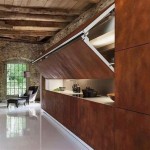Update Kitchen Cabinets With Molding: Essential Aspects
In home improvement, updating kitchen cabinets with molding is a crucial aspect that can significantly enhance aesthetics and functionality. The addition of molding creates intricate details, elevates the overall cabinetry design, and complements the kitchen's décor. This article explores the essential aspects of updating kitchen cabinets with molding, providing valuable insights for homeowners seeking to transform their kitchen spaces. ### Types of Molding Moldings come in various shapes and sizes, each serving a specific purpose. Some common types include: -Crown Molding:
Installed at the top of cabinets, crown molding adds a decorative finish that conceals any gaps between cabinetry and ceiling. -Base Molding:
Applied at the bottom of cabinets, base molding prevents moisture damage and adds a finished look. -Valance Molding:
Installed beneath the cabinet's bottom edge, valance molding conceals hardware and adds a decorative touch. -Light Rail Molding:
Used to conceal under-cabinet lighting, light rail molding creates ambient lighting while enhancing aesthetics. ### Material Selection The material of the molding plays a crucial role in its durability, appearance, and cost. Popular options include: -Wood:
Available in various species, wood molding offers a classic and elegant look. It is durable and can be painted or stained to match the cabinetry. -MDF (Medium-Density Fiberboard):
A cost-effective alternative to wood, MDF molding is easy to paint or laminate. It is moisture-resistant, making it suitable for kitchens. -Polyurethane:
Lightweight and versatile, polyurethane molding is resistant to moisture, termites, and dents. It is a cost-effective option with a wide range of finishes. ### Installation Considerations Proper installation is essential for a flawless finish. Factors to consider include: -Cutting:
Molding must be cut precisely to fit the cabinet's dimensions. Miters (angled cuts) are often necessary for corners. -Adhesive:
Using the correct adhesive, such as construction adhesive or liquid nails, ensures a secure bond between the molding and cabinetry. -Finishing:
After installation, molding may be painted, stained, or caulked to match the existing cabinetry and enhance its appearance. ### Conclusion Updating kitchen cabinets with molding is a transformative project that elevates aesthetics and functionality. By understanding the types of molding, selecting the right material, and considering installation considerations, homeowners can create a kitchen space that is stylish, practical, and a source of pride.
Diy Kitchen Cabinet Upgrade With Paint And Crown Molding

10 Types Of Kitchen Cabinet Molding For Your Home

How To Add Trim And Paint Your Laminate Cabinets

My Designer Secret For Updating Old Kitchen Cabinets Maria Killam

Adding Moldings To Your Kitchen Cabinets Remodelando La Casa

Crown Moulding The Recently Rediscovered Kitchen Solution

Adding Moldings To Your Kitchen Cabinets Remodelando La Casa

Adding Crown Molding To Kitchen Cabinets Young House Love

Diy Kitchen Cabinet Upgrade With Paint And Crown Molding

Consider Molding For Your Kitchen Cabinets Cabinetry In Annapolis Md
Related Posts








